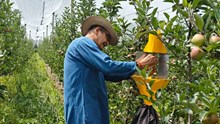
Goat farming is one of the most lucrative ventures in the livestock industry owing to low capital, high yields, and the ability of goats to thrive in different climates. However, without effective health management, diseases can quickly spread and affect a whole herd. The secret to saving goats and maintaining revenue is early detection and, above all, prevention. Let us learn some of the diseases that are prevalent in goats, their symptoms, causes, and how farmers can safeguard their livestock:
Blue Tongue (BT)
Blue Tongue is a viral infection that mostly occurs in goats and sheep. It is transmitted by biting insects like Culicoides midges, mosquitoes, and sheep ked. In certain instances, the infection can also be transmitted through semen or the placenta. The virus is very resistant and can remain in the environment for a long period of time.
Goats infected with BlueTongue can develop fever, display signs of depression, and present nasal and oral discharge. The tongue can become swollen and bluish. In other cases, the goat can exhibit lameness, twisted neck, or face breathing problems.
Prevention is best done by early vaccination. The first vaccine should be administered when the child is three months, with a repeat annually. Farmers have to keep insects at bay using sprays and repellents. Affected goats should be isolated as soon as possible to prevent further transmission of the virus.
Peste des Petits Ruminants (PPR)
PPR is perhaps the most dreaded disease among goat producers. It is highly contagious by direct contact with affected animals or through contaminated water and feed. PPR is caused by the Morbillivirus and primarily infects goats more than sheep. Affected animals have a high fever, become dull and weak, and lose their appetite. Eyes and nose begin to discharge fluid, and mouth ulcers can develop.
The animal can develop pneumonia-like signs, diarrhea, and in pregnant goats, abortions. The most effective protection is vaccination at three months of age with booster shots annually. Farmers must maintain strict hygiene procedures, avoid overcrowding, and quarantine new animals before introducing them to the herd.
Goat Pox
Goat Pox is a viral contagious infection by Capripoxvirus. It is transmitted by direct contact with infected animals, infectious feed or equipment, and biting insects. Infected goats have papules or nodules on the skin, particularly on the face, ears, and legs. The eyes and nostrils may discharge mucus, and some may exhibit labored breathing.
Vaccination still remains the most reliable protection. Children should be vaccinated by farmers at three months and receive annual shots. The housing must be clean, and sick animals need to be isolated to avoid disease transmission.
Tetanus
Tetanus is produced by the Clostridium tetani bacterium, which enters the animal's body as a result of deep wounds following operations such as ear tagging, castration, or kidding. The bacteria then release toxins, which target the nervous system. Initial symptoms consist of rigidity in the legs, walking problems, and exaggerated sensitivity to sound or touch. In advanced situations, the goat's jaw might become locked so that it can neither eat nor drink.
Vaccination at the time of birth and periodic booster doses are crucial. Farmers must always properly clean wounds and apply antiseptics. Any surgical or wound process has to be conducted in clean, hygienic conditions.

General Prevention Practices for Healthy Goat Farming
To ensure herd health, farmers have to go on a regular vaccination regimen, keep goat sheds hygienic, provide clean water and food, and quarantine at once any sick animal. New goats would always have to be kept in quarantine for 14 days prior to integrating them with the herd. Insecticide control using sprays and conventional means reduces the risk of disease transmission.
Regular checkups by a resident veterinarian and maintenance of each goat's health record provides an added sense of security for your livestock venture.
Recommended Vaccination Schedule for Goats
|
Disease |
First Vaccination Age |
Booster or Repeat Vaccination |
|
Tetanus |
Immediately after birth |
Once a year |
|
Blue Tongue |
3 months |
Every year |
|
PPR |
3 months |
Every year |
|
Goat Pox |
3 months |
Every year |
|
Anthrax |
6 months |
Every year |
|
Enterotoxaemia |
1.5 months |
Every year |
|
Foot-and-Mouth (FMD |
4 months |
Every 6 months |
Healthy goats mean a healthy livelihood. Most goat diseases can be prevented with proper vaccination, hygiene, and early care. Remember, it’s easier and cheaper to prevent diseases than to treat them after an outbreak. A small investment in regular health management can save the entire herd and increase your income many times over. Consult your local veterinarian regularly, and never ignore early signs of illness. Prevention truly is the best cure when it comes to goat farming.
















